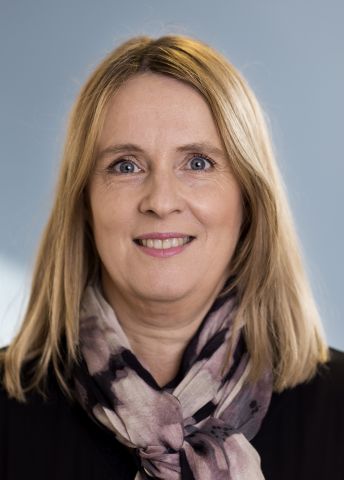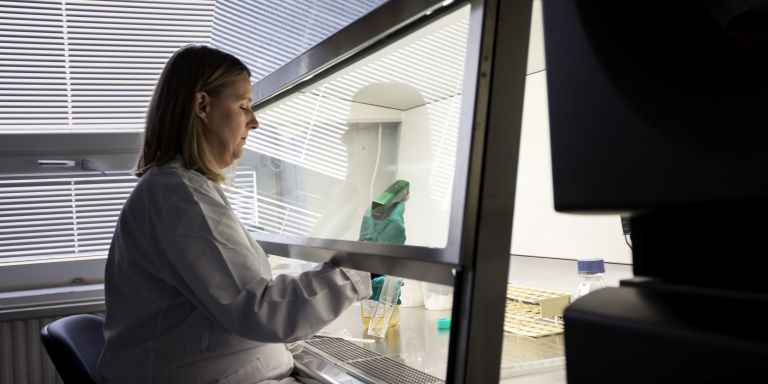
Maria Falkenberg
Professor of Biomedical Laboratory Science
Wallenberg Scholar
Institution:
University of Gothenburg
Research field:
Regulation and copying of mitochondrial DNA


Wallenberg Scholar
Institution:
University of Gothenburg
Research field:
Regulation and copying of mitochondrial DNA
Mitochondrial DNA, abbreviated mtDNA, is a fairly new and unexplored area. Falkenberg is one of the pioneers. She was the first person in the world to build a model system in test tubes in which mitochondrial DNA was copied in the same way as in the cell.
“I am interested in finding out which mechanisms and which proteins are involved – how mtDNA is copied, how it is regulated. There’s so much we don’t know.”
mtDNA plays a central role in several diseases. It is estimated that one person in 5,000 develops some form of mitochondrial disease, of which many are deadly. Some begin as early as the fetal stage and birth; others do not strike until puberty or adulthood.
“Each individual disease is uncommon, but as a group they are not as unusual,” Falkenberg explains.
Symptoms, too, vary. Mitochondrial disease particularly affects tissues or organs that need a lot of energy, e.g. muscles and the brain. Symptoms include epileptic fits, kidney failure, eye diseases, muscle weakness, brain damage and neurological damage.
“There is also evidence suggesting that mtDNA plays a part in age-related diseases such as Parkinson’s and diabetes, as well as the normal ageing process itself. My research team and I are concentrating our studies on trying to understand how mtDNA is copied and to understand why it sometimes goes wrong, leading to mutations or rearrangements. There are many different mutations, which is what causes the pattern of symptoms and time of onset to vary so much,” Falkenberg explains.
Mitochondria are the powerhouses of the cells. They produce fuel in the form of adenosine triphosphate (ATP), which can then be used by other parts of the cell. They differ from the cell’s other structures, the organelles, since they have their own genome, mtDNA, which is entirely separate from the DNA found in the cell nucleus. Upon fertilization, the mitochondria come from the mother’s egg. This means that mtDNA and diseases caused by mutations in mtDNA can only be inherited from the mother.
One major difference between the two genomes is the number of genes. The cell nucleus genome contains 22,000 genes, whereas there are only 37 in mtDNA. Thirteen of those genes code for proteins. In addition, each cell contains between 1,000 and 10,000 copies of the mtDNA, whereas we only have two copies of each chromosome in the cell nucleus.
“We want to find out what regulates the number of copies there are in each cell. Another major difference is that many of the repair mechanisms existing for DNA in the cell nucleus are missing for mtDNA. If the mtDNA is split in two pieces, for example, it is broken down instead of being repaired. We are currently studying how this process works.”
"The Scholar grant will allow my coworkers and myself to pursue challenging, high-risk projects that hopefully will generate new exciting discoveries."
Falkenberg explains that the number of healthy DNA molecules is a critical factor for disease:
“Mutations in mtDNA are hardly ever dominant, and symptoms of disease occur when someone has too few copies of healthy mtDNA.”
One approach to treating mitochondrial diseases that Falkenberg and her colleagues are currently examining is to increase the number of copies of healthy mtDNA in the cell. This has been found to work in animal models for mitochondrial disease.
“If you have 400 healthy copies and 600 diseased copies of mtDNA, you are sick. But if we can increase the number to 800 healthy copies and 1,200 diseased ones, the symptoms disappear. There have to be enough healthy copies of mtDNA for the mitochondria to do their job.”
Although Falkenberg is a biochemist specializing in protein purification, she sometimes also helps her clinical colleagues to assess the effects of various mutations in patients with mitochondrial disease.
Falkenberg’s interest in mathematics and natural sciences led her to an undergraduate degree in molecular biology after high school. Much of her time as a PhD student was spent at Stanford in the U.S., where she worked with Robert Lehman as her supervisor, studying DNA replication in herpes viruses.
“Lehman was involved in several fundamental discoveries in DNA replication, and it was while working with him that I learned many of the techniques that I still use today.”
A chance meeting with another Swedish researcher, Nils-Göran Larsson, in an elevator at Stanford marked the start of her interest in mitochondria. She eventually joined his research team in Stockholm. And it was there she built the first mitochondrial model system in test tubes. After a time she set up her own research team at Karolinska Institutet, before moving to the University of Gothenburg.
“I began working on mtDNA at the right time. It’s incredibly stimulating. I’ve been able to break a lot of new ground – it’s actually a little surprising that no one has done it before. Over the past we have come a long way toward understanding how mtDNA is copied and regulated. We hope to find ways of helping people who are suffering from mitochondrial diseases.”
Text Carina Dahlberg
Translation Maxwell Arding
Photo Johan Wingborg, Magnus Bergström
The primary task of mitochondria is to ensure that the body converts the right amount of energy to enable us to move, grow and think, for example. But they also play a key role in controlling cell development and death.
Each cell contains a large number of mitochondria. They are thought to have originated from bacteria that were built into primitive cells more than a billion years ago, making it possible for our cells to make use of oxygen. Numerous chemical reactions take place in mitochondria to convert energy in the various organs in the body.
mtDNA – mitochondrial DNA – is only passed on by the mother, and is linked to a number of genetic diseases. In a mitochondrial disease, the mitochondria do not work as they should, causing symptoms that may occur virtually anywhere in the body.